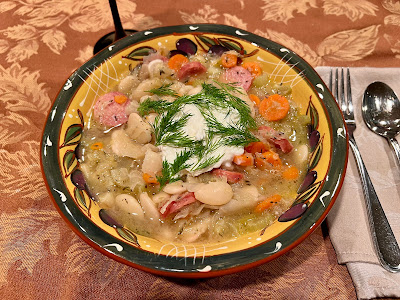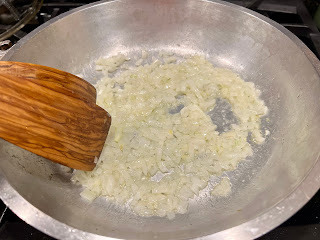Credit for this delicious soup goes to my friend
Lori Lynn, owner of Taste with the Eyes.
Sauerkraut soup, also known as Kapuśniak in
Polish, is a traditional Eastern European dish that features fermented cabbage
as a key ingredient.
Kapuśniak typically contains a variety of vegetables
such as carrots, onions, and potatoes. These vegetables add sweetness and depth
to the soup. Instead of potatoes, this version features plump large lima beans.
A good source of protein and fiber – large lima beans have a creamy texture,
and a slightly sweet, buttery flavor.
Smoked sausage or kielbasa are often added to sauerkraut
soup too, as I did here in my version, but the soup can easily be vegetarian by leaving the sausage out and switching to a vegetable stock. It’s a great comfort food,
and many variations of the recipe exist, allowing for personal preferences and
regional differences.
Dill is popular in Polish cuisine – bright and grassy,
herbaceous and aromatic, fresh dill enhances the overall sensory experience of
soup. And here, a generous dollop of sour cream balances out the
sauerkraut. A
good artisan
bread with butter is the perfect accompaniment for dunking in
the savory sour broth. Enjoy!
Ingredients:
- 3 tbsp olive oil
- 2 carrots - sliced
- 1 celery rib - thinly sliced
- 1/2 onion - diced
- 4 garlic cloves - thinly sliced or smash-minced
- 1 tsp dried thyme
- 1/8 tsp ground allspice
- 2 cups reserved bean water
- 2 cup chicken stock (use vegetable stock for vegetarian version)
- 1 1/2 tsp whole grain mustard (I use Gulden's Spicy Brown Mustard)
- 2 cups cooked lima beans - bean water reserved
- 14-15 oz can sauerkraut - well-drained (and rinsed if less sour
flavor is preferred)
- 8-12 oz low sodium turkey kielbasa - sliced to bite size (leave out for vegetarian version)
- sea salt and fresh ground pepper to taste
Preparation:
Heat olive oil in a soup pot over medium heat. Add carrot, celery and onion, cooking until softened. Add garlic, thyme, and allspice and cook a few more minutes, stirring frequently.
Add bean water, chicken stock, mustard and sauerkraut.
Raise the heat and bring to a boil. Lower the heat and simmer 15 minutes, then
add the lima bean mix and kielbasa to heat through. Season to taste with salt and pepper.
How to cook raw lima beans:
- 8 oz dried large
white lima beans - rinsed and sorted
- 1 medium carrot - rough chopped
- 1 medium celery rib - rough chopped
- 1/4 yellow onion - rough chopped
- 4 garlic cloves - smashed
- a few glugs of olive oil
- sea salt to finish
Place beans, carrot, celery, onion, and garlic in a pot. Add
filtered water to cover by two inches. Add olive oil. Boil for 15 minutes then
reduce heat to a simmer and cook until beans are tender, usually 1-2 hours. Add salt to taste near
the end of cooking. Pour mixture into a suitable strainer and reserve the cooking water.
To Serve Finished Soup:
- fresh dill
- sour cream
- your favorite artisan bread & butter
Ladle hot soup into warm bowls. Top with fresh snipped dill
and a generous dollop of sour cream. Serve with bread and butter.
Carnivore Bowl
Blessed be... and happy cooking!


















































